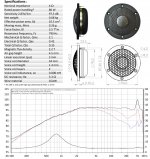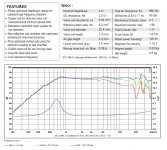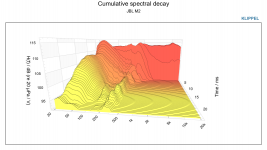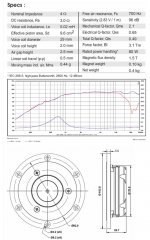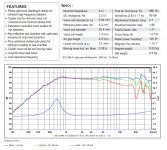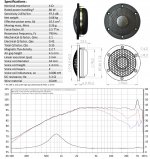As PB noted, the dynamics tests are really something to think about. Thank you for sharing.
I've always been wary of using beryllium tweeters, despite the fact that designers like Voecks promote them. To me, it's been difficult to get excited about a $300-$400 tweeter, when you can get aluminum tweeters for $50 that are so good.
When you ask people why they like beryllium, they'll say that they're "airy." And it's hard for me to triple or quadruple the cost of a speaker, just for more "air."
But one interesting thing to consider, is that a beryllium tweeter should be able to offer better dynamics than aluminum. For instance, the Bliesma 34mm beryllium tweeter is about 6dB more efficient than the SB Acoustics SB26ADC.
Normally I don't lose much sleep over the efficiency of drivers; I figure that if I need more efficiency I'll just use more drivers. But with tweeters you don't really have the luxury of using multiple units, unless you opt for something like a Paraline or a DOSC.
To make a long story short, $700 is a lot for a pair of tweeters, but it looks like it could increase the dynamic potential of the speaker by as much as 6dB. That's quite a bit.
Attachments
Great information Erin. I appreciate your work and have been subscribed to your YT channel forever.
Your the man... Someone made the comment that exaggerated spectral decays would potentially be masked...I agree but obviously there is a threshold. At some point the lingering resonance will cause that area of the spectrum to appear abundantly in comparison to the shorter ringing of the other portions of the spectrum...if Im not mistaken ribbons have excellent performance in this area.
They above measurement is clean as heck for the most part.
You still have csd of the dutch 8c laying around lol
They above measurement is clean as heck for the most part.
You still have csd of the dutch 8c laying around lol
Last edited:
Too much punk, too little bikini. [emoji16]Great information Erin. I appreciate your work and have been subscribed to your YT channel forever.
+1.You still have csd of the dutch 8c laying around lol
consider...that a beryllium tweeter should be able to offer better dynamics than aluminum. For instance, the Bliesma 34mm beryllium tweeter is about 6dB more efficient than the SB Acoustics SB26ADC.
...$700 is a lot for a pair of tweeters, but it looks like it could increase the dynamic potential of the speaker by as much as 6dB. That's quite a bit.
The actual benefit of beryllium on the efficiency is small.
The benefit of $700 is not small, however.
The Bliesma has more "Force Factor", probably from more magnet, it's a heavier speaker, diameter is more so it moves more air and Mms is smaller.
Obviously a more expensive speaker can afford to use better components and I assume that that's where most of the improvement comes from.
And beryllium speaker tend to be more expensive so it's classic "correlation not causation".
Beryllium can potentially reduce Mms but can't help reduce the voice coil mass, which is typically about half or more.
So it doesn't help much for an otherwise similar speaker.
Compare the beryllium domed compression drivers with the aluminium ones.
Pretty similar efficiency, as I was disappointed to confirm when I did the numbers.
Best wishes
David
Another consideration, the effiency only is there on axis and off axis the response drops fast. A waveguided tweeter like the scanspeak H2606 shows similar behavior.
Beryllium can potentially reduce Mms but can't help reduce the voice coil mass, which is typically about half or more.
So it doesn't help much for an otherwise similar speaker.
I don't completely agree with that since the voice coil weight is proportionally rising with diameter. But the dome area is rising with the square of the diameter. Therefore you can gain in terms of Sd/Mms with materials that show a good stiffnes/weight ratio.
Regards
Charles
...in terms of Sd/Mms with materials that show...
Hi Charles
Yes, better materials can help improve Sd/Mms.
But my point was that it doesn't help all that much because a lot of the mass is in the voice coil, coil former and the movable part of the suspension.
And beryllium is still two thirds the density of aluminium.
Stiffer too, but if we make the dome much thinner than we lose the benefit of the increased break-up frequency.
And if we increase the diameter to exploit the scale factor, as you posted, then the speaker becomes more directional and beams at lower frequency.
Much of the improvement in "Patrick"s example is just because the more expensive speaker has almost double the flux density and better BL, not from the beryllium dome.
When I did the maths for beryllium domes in my compression drivers I found the improvement smaller than I had hoped.
But I would still like them😉
Best wishes
David
Waterfall / CSD type graphs are the most difficult to interpret properly and the view can be completely changed by the values used in the program generating the graphic.Your the man... Someone made the comment that exaggerated spectral decays would potentially be masked...I agree but obviously there is a threshold. At some point the lingering resonance will cause that area of the spectrum to appear abundantly in comparison to the shorter ringing of the other portions of the spectrum...if Im not mistaken ribbons have excellent performance in this area.
They above measurement is clean as heck for the most part.
You still have csd of the dutch 8c laying around lol
Managing the time frequency tradeoff to see when where resonances occur is difficult particularly as frequency goes down.
More incorrect conclusions have been drawn from these graphs than any other. I can understand why Erin does not choose to post them as a matter of course.
The actual benefit of beryllium on the efficiency is small.
The benefit of $700 is not small, however.
The Bliesma has more "Force Factor", probably from more magnet, it's a heavier speaker, diameter is more so it moves more air and Mms is smaller.
Obviously a more expensive speaker can afford to use better components and I assume that that's where most of the improvement comes from.
And beryllium speaker tend to be more expensive so it's classic "correlation not causation".
Beryllium can potentially reduce Mms but can't help reduce the voice coil mass, which is typically about half or more.
So it doesn't help much for an otherwise similar speaker.
Compare the beryllium domed compression drivers with the aluminium ones.
Pretty similar efficiency, as I was disappointed to confirm when I did the numbers.
Best wishes
David
Great post, I think you may have saved me $500 🙂
I went looking at tweeters based on BL instead of diaphragm material, and found that there a $150 Satori tweeter with an efficiency of 95dB that uses silk, not beryllium. In the attached spec sheets, note how the Satori tweeter has twice as much BL as the less expensive ($50) option, and is 5dB more efficient.
Attachments
Bennett Prescot from B&C has a nice video where he talks about transducer parameters, including BL.
It's in one of these two videos transducer freq resp or T-S parameters in the 21st century. Or maybe this one power handling deep dive. 😛
It's in one of these two videos transducer freq resp or T-S parameters in the 21st century. Or maybe this one power handling deep dive. 😛
@camplo, here you go!
I love what the Klippel can do, this horrific window into time, that really shows the long lasting resonances. What it be possible to see a "standard" CSD? 4 to 5 ms long time window, 0.15 ms rise time, 25-30 dB span?
Last edited:
...I think you may have saved me $500
If I ever make it back to the USA you can buy me a drink😉
...tweeters based on BL instead...
Just be aware that the parameter that matters is actually BL squared divided by Re.
So you can only directly compare BL for speakers with the same impedance, as your two examples conveniently were.
Best wishes
David
Bennett Prescot from B&C has a nice video where he talks about transducer parameters, including BL.
It's in one of these two videos transducer freq resp or T-S parameters in the 21st century. Or maybe this one power handling deep dive. 😛
Thank you, it start's here:
T-S Parameters in the 21st Century - YouTube
Too much punk, too little bikini. [emoji16]
That’s on my OnlyFans page. 😀
Great post, I think you may have saved me $500 🙂
I went looking at tweeters based on BL instead of diaphragm material, and found that there a $150 Satori tweeter with an efficiency of 95dB that uses silk, not beryllium. In the attached spec sheets, note how the Satori tweeter has twice as much BL as the less expensive ($50) option, and is 5dB more efficient.
New issue of VC is out and they tested 3 versions of the 25mm BlieSMA tweeters.
Waterfall / CSD type graphs are the most difficult to interpret properly and the view can be completely changed by the values used in the program generating the graphic.
Managing the time frequency tradeoff to see when where resonances occur is difficult particularly as frequency goes down.
More incorrect conclusions have been drawn from these graphs than any other. I can understand why Erin does not choose to post them as a matter of course.
Wheres the complication at? Probably only slightly more complicating than a frequency response graph. I know what you are referring to about low frequency reading...in this instance burst decay brings back simple analysis....I keep a pic of text book perfect CSD for reference but the burst decay accounts for frequency size...I think the correct word to describe how burst decay displays frequency is "normalization" of the time scale.
- Home
- Loudspeakers
- Multi-Way
- JBL M2 for The Poors
